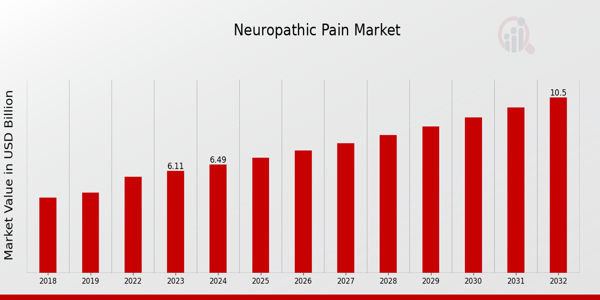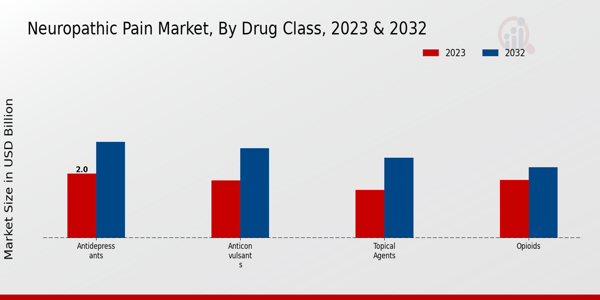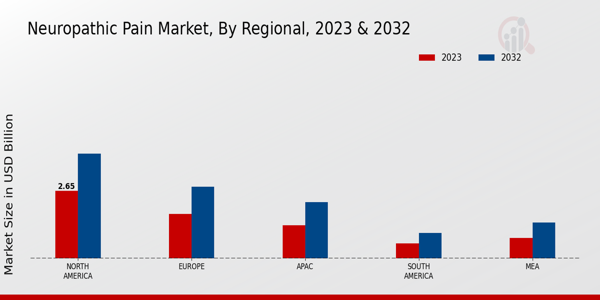Neuropathic Pain Market Overview
As per MRFR analysis, the Neuropathic Pain Market Size was estimated at 5.51 (USD Billion) in 2023.The Neuropathic Pain Market Industry is expected to grow from 5.79(USD Billion) in 2024 to 10.1 (USD Billion) by 2035. The Neuropathic Pain Market CAGR (growth rate) is expected to be around 5.18% during the forecast period (2025 - 2035).
Key Neuropathic Pain Market Trends Highlighted
The Neuropathic Pain Market is expanding at a fast rate due to the rising popularity of chronic pain conditions and the growing awareness regarding pain management. There is an increasing prevalence of diabetic neuropathy, post-herpetic neuralgia, fibromyalgia, and other chronic ailments which is increasing the market need for treatment of neuropathic pain. Moreover, changes in marketed drug therapies due to newer drug developments and therapeutics are enhancing the patient treatment options.
More and more healthcare have customized therapies to deal with pain issues, leading to the development of specialized medication and targeted surgery. There is more than sufficient scope in the market, especially concerning combination therapy and non-surgical treatment development.
Interest is growing on integrating behavioral therapies alongside pharmacological therapies in pain management, as a more holistic approach. Additionally, focus on innovation in medical technology around the world creates an opportunity to develop neuromodulation devices that can provide relief to patients in a less invasive manner. There is a trend towards personalized medicine in managing chronic pain.
With healthcare systems worldwide adopting precision medicine frameworks, there is increased emphasis on tailoring treatments to specific patients. There is further ongoing research into the genetics and biomarkers of pain, which may lead to more effective and personalized treatments.
The international sphere is marked by an ongoing collaboration between pharmaceutical companies, healthcare professionals, and academic research to address the problem of chronic pain and develop effective treatment options for it, which takes into consideration the rising prevalence of chronic pain as a global health issue.

Neuropathic Pain Market Drivers
Increase in Neuropathic Pain Disorders
The Neuropathic Pain Market Industry is fueled by the growing incidence of neuropathic pain disorders, including diabetic neuropathy and post-herpetic neuralgia. According to the International Association for the Study of Pain, approximately 7-10% of the global population suffers from neuropathic pain at some point in their lives. This statistic suggests millions of individuals globally are affected, leading to increased demand for effective treatments and therapies.
Organizations such as the American Chronic Pain Association emphasize the need for early intervention and treatment options to improve the quality of life for these patients, thus driving market growth in the Neuropathic Pain Market Industry.
Rising Aging Population
The aging population globally is a significant driver for the Neuropathic Pain Market Industry. The World Health Organization states that the number of people aged 60 years and older is expected to double from 1 billion in 2020 to 2.1 billion by 2050. As age increases, the prevalence of neuropathic pain also tends to rise, prompting the need for more effective pain management strategies.
Established organizations are increasingly focusing on geriatric health, thereby increasing research funding for regenerative and pain management therapies, which positions the Neuropathic Pain Market Industry for growth.
Advancements in Treatment Options
Innovation plays a critical role in the Neuropathic Pain Market Industry, with ongoing advancements in treatment methodologies such as drug formulations and therapeutic devices. The U.S. Food and Drug Administration has approved several new medications over recent years aimed specifically at treating neuropathic pain, contributing to more efficient treatment landscapes.
This approval trend, coupled with research investments from major pharmaceutical companies, reflects the industry's commitment to improving patient outcomes for neuropathic pain.These advancements have been recognized worldwide, further validating the need for updated and novel approaches to pain management, enhancing market growth prospects.
Increased Awareness and Education
Growing awareness and education regarding neuropathic pain have become paramount in the Neuropathic Pain Market Industry. Health campaigns initiated by organizations like the Neuropathy Action Foundation highlight symptoms, treatment options, and coping strategies, which have resulted in greater public awareness about the condition.
For instance, initiatives have led to a reported 15% increase in patient consultations for neuropathic pain concerns within the last five years, as stated by community health organizations.This heightened awareness translates into increased screening and diagnosis rates, subsequently boosting demand for effective therapeutic solutions in the Neuropathic Pain Market Industry.
Neuropathic Pain Market Segment Insights
Neuropathic Pain Market Type of Neuropathic Pain Insights
The Neuropathic Pain Market is primarily categorized by the type of neuropathic pain, a critical segment illustrating varied pain conditions of significant concern globally. In 2024, the market was valued at approximately 5.79 USD Billion, demonstrating the growing recognition of neuropathic pain as an important health issue. Among the different types, Diabetic Neuropathy stands out, holding a significant market share valued at 1.73 USD Billion in 2024 and projected to reach 3.01 USD Billion by 2035.
The increasing prevalence of diabetes worldwide drives the demand for effective management of this condition, making it a vital area in the Neuropathic Pain Market.
Postherpetic Neuralgia
Postherpetic Neuralgia follows as another crucial category, valued at 1.35 USD Billion in 2024 and projected to grow to 2.39 USD Billion by 2035. This type is especially significant due to its association with shingles, a viral condition that can lead to persistent pain that affects a considerable portion of the population.
Trigeminal Neuralgia
Trigeminal Neuralgia, categorized with a market valuation of 1.10 USD Billion in 2024, is recognized for its debilitating facial pain, affecting quality of life and driving healthcare utilizations. It is anticipated to increase to 1.90 USD Billion by 2035, demonstrating rising awareness and treatment options that are fueling market growth.
Chemotherapy-Induced Peripheral Neuropathy
Chemotherapy-Induced Peripheral Neuropathy, valued at 1.61 USD Billion in 2024 and expected to reach 2.70 USD Billion by 2035, also plays a significant role, as cancer survivorship is on the rise, leading to a growing population requiring pain management solutions. This segment reflects a pressing need for new therapies to manage neuropathic pain resulting from cancer treatments, which has gained importance in recent years.
Overall, the Neuropathic Pain Market segmentation by type showcases a landscape where certain conditions dominate in prevalence and impact, shaping market dynamics while showcasing opportunities for innovative treatments and therapeutic approaches to address these pain conditions. Increased public health initiatives and advancements in pain management technologies are likely to further uplift this market within the global health scenario.

Neuropathic Pain Market Treatment Type Insights
The Neuropathic Pain Market, particularly focusing on the Treatment Type segment, was valued at 5.79 billion USD in 2024, showcasing significant growth potential in the coming years. The market comprises various treatment options such as Medications, Physical Therapy, Surgical Procedures, and Electrical Stimulation, each playing a vital role in managing neuropathic pain.
Medications typically provide the primary approach, addressing pain relief through a combination of analgesics, anticonvulsants, and antidepressants, which are crucial for patient management.Additionally, Physical Therapy serves as a practical solution, enhancing recovery and function, catering to those seeking non-invasive options.
Surgical Procedures represent a targeted approach for severe cases, often employed when other treatments fail. Meanwhile, Electrical Stimulation methods, including transcutaneous electrical nerve stimulation, are gaining traction due to their innovative approach in pain management. The demand for effective treatment solutions continues to rise, driven by an increasing prevalence of neuropathic conditions and a growing aging population globally, thereby influencing the overall Neuropathic Pain Market revenue and its segmentation dynamics.
Neuropathic Pain Market Route of Administration Insights
The Neuropathic Pain Market is anticipating robust growth, with its overall valuation reached 5.79 billion USD in 2024. Within this market, the Route of Administration is a pivotal segment, comprising various methods, such as Oral, Topical, and Injectable. The Oral route is significant due to its convenience and patient compliance, often being the first choice for chronic pain management.
Meanwhile, the Topical administration is emerging as a preferred option for localized treatment, providing targeted relief with minimal systemic effects.Injectable routes, on the other hand, are essential for acute pain management and situations where immediate relief is necessary, frequently used in clinical settings.
The increasing prevalence of neuropathic pain worldwide, combined with advancements in pain management therapies, is a vital driver for growth in this sector. As patient populations expand and the demand for effective pain relief solutions escalates, the Neuropathic Pain Market segmentation underscores the importance of diverse administration routes, catering to varied patient needs and treatment preferences.This dynamic market is expected to flourish, offering a range of options to enhance patient quality of life.
Neuropathic Pain Market End User Insights
The Neuropathic Pain Market's End User segment is anticipated to play a crucial role in shaping the market landscape by focusing on healthcare delivery settings. In 2024, the overall market was valued at 5.79 billion USD, reflecting a significant market growth trajectory driven by rising incidences of neuropathic pain conditions. Within this domain, various sectors are engaged in providing relevant treatments, with hospitals representing a pivotal part of the structure due to their capability to offer advanced care and specialized therapies.
Clinics also contribute a substantial share as they cater to patients seeking outpatient care and have become instrumental in pain management approaches. Additionally, the Home Care segment has gained traction, particularly for chronic pain management, promoting patient comfort and adherence to ongoing treatment plans.
Global trends show a shift towards personalized and accessible pain management solutions, addressing the growing need for effective interventions. The ongoing advancements in Research and Development, as well as increased healthcare funding for neuropathic pain treatments, create ample opportunities for growth within this market segment.While the sector faces challenges such as regulatory hurdles and varying healthcare policies across regions, the demand for innovative pain relief solutions is expected to drive the Neuropathic Pain Market forward in the coming years.
Neuropathic Pain Market Regional Insights
The Neuropathic Pain Market exhibits substantial regional differentiation, with North America leading the way, valued at 2.45 USD Billion in 2024, and projected to reach 4.25 USD Billion by 2035, accounting for a majority holding due to advanced healthcare infrastructure and high prevalence of neuropathic disorders. Europe follows with a valuation of 1.75 USD Billion in 2024, expanding to 3.15 USD Billion, reflecting robust Research and Development practices and increasing awareness regarding pain management therapies.
The Asia-Pacific (APAC) region, valued at 1.20 USD Billion in 2024 and growing to 2.05 USD Billion, is gaining traction due to rising patient populations and growing economies investing in healthcare innovation.South America shows modest figures, valued at 0.27 USD Billion in 2024 and anticipated to reach 0.47 USD Billion by 2035, driven by an increasing focus on healthcare access.
The Middle East and Africa (MEA) segment holds the smallest share, valued at 0.12 USD Billion in 2024 and projected at 0.18 USD Billion, reflecting the need for enhanced medical infrastructures and access to pain management therapies. The significance of these regional markets is influenced by factors such as demographic changes, economic conditions, and varying healthcare regulations, shaping the growth dynamics within the Neuropathic Pain Market industry.

Neuropathic Pain Market Key Players and Competitive Insights
The Neuropathic Pain Market is characterized by a highly competitive landscape with numerous players striving for market share through innovation, strategic partnerships, and expanding their product lines. This market encompasses a range of treatments and therapies targeted at alleviating neuropathic pain, which is often a complex condition resulting from nerve damage or dysfunction. With increasing acknowledgment of neuropathic pain's multifaceted nature, companies are diversifying their approaches, investing in research and development efforts, and focusing on patient-centric solutions.
Key trends in this industry involve the development of novel pharmacological agents alongside advancements in non-pharmacological therapies, ensuring that diverse treatment options are available for patients worldwide. The competitive dynamics are further impacted by regulatory hurdles, market access considerations, and an increasing emphasis on personalized medicine, leading companies to adopt differentiated strategies to maintain their competitive edge.
Pfizer
Pfizer has established a notable presence in the Neuropathic Pain Market, largely due to its strong portfolio of analgesics that address various pain pathways. With global operations and a commitment to innovation, Pfizer leverages its extensive research and development capabilities to introduce effective therapies for neuropathic pain management. The company's strengths lie in its reputation for quality, a well-recognized brand, and a dedicated focus on addressing unmet medical needs in the pain management sector.
Pfizer's strategic collaborations and partnerships with healthcare providers and organizations worldwide enhance its market reach and support its efforts to advance neuropathic pain therapies that align with contemporary medical practices. Additionally, Pfizer's commitment to education and support for healthcare professionals ensures that its products are effectively integrated into treatment regimens, further fortifying its competitive positioning in the global market.
Merck and Co
Merck and Co has been a formidable player in the Neuropathic Pain Market, enhancing its portfolio with key products that cater to the treatment of neuropathic pain. The company leverages its deep expertise in pharmacology and a commitment to research, continuously improving its existing therapies while also developing innovative solutions for pain management. Merck and Co's strengths include a robust pipeline of products in development, positioning itself well against competitors.
The company has also engaged in strategic mergers and acquisitions to bolster its capabilities in this therapeutic area, allowing for the combination of resources, knowledge, and technological advancements.
Such strategic moves facilitate Merck and Co's expansion into new markets and reinforce its position as a leader in treating neuropathic pain. The company's global presence, supported by a vast network of distribution channels and partnerships with healthcare professionals, further enhances its ability to deliver effective treatments and maintain a significant footprint in the global neuropathic pain arena.
Key Companies in the Neuropathic Pain Market Include:
- Pfizer
- Merck and Co
- AbbVie
- Eli Lilly
- Boehringer Ingelheim
- Johnson and Johnson
- Teva Pharmaceutical Industries
- Novartis
- Celgene
- Mylan
- Astellas Pharma
- NantKwest
- GlaxoSmithKline
- Amgen
- Sanofi
Neuropathic Pain Market Industry Developments
The Neuropathic Pain Market has seen significant developments recently, particularly with increased R&D investments from major companies like Pfizer, AbbVie, and Eli Lilly looking to introduce innovative therapies. In the last few months of 2023, notable advancements in gene therapies aimed at pain management have been highlighted. Companies such as Merck and Co and Johnson and Johnson are also focusing on developing new pharmacological solutions, responding to the rising global prevalence of neuropathic pain, which affects an estimated 7-10% of the population worldwide.
In terms of mergers and acquisitions, although no recent amalgamations have been disclosed by Pfizer or Novartis, industry analysts anticipate potential collaborations aimed at enhancing product portfolios in the neuropathic pain segment. Moreover, market valuations for firms like Teva Pharmaceutical Industries and Boehringer Ingelheim have seen a substantial rise due to strategic partnerships, thereby positively influencing the overall market landscape.
Growth within the sector is attributed to an aging population and heightened awareness regarding chronic pain, prompting pharmaceutical companies to innovate and expand their offerings to cater to this growing need.
Neuropathic Pain Market Segmentation Insights
Neuropathic Pain Market Type of Neuropathic Pain Outlook
- Diabetic Neuropathy
- Postherpetic Neuralgia
- Trigeminal Neuralgia
- Chemotherapy-Induced Peripheral Neuropathy
Neuropathic Pain Market Treatment Type Outlook
- Medications
- Physical Therapy
- Surgical Procedures
- Electrical Stimulation
Neuropathic Pain Market Route of Administration Outlook
Neuropathic Pain Market End User Outlook
- Hospitals
- Clinics
- Home Care
Neuropathic Pain Market Regional Outlook
- North America
- Europe
- South America
| Report Attribute/Metric Source: |
Details |
| MARKET SIZE 2023 |
5.51(USD Billion) |
| MARKET SIZE 2024 |
5.79(USD Billion) |
| MARKET SIZE 2035 |
10.1(USD Billion) |
| COMPOUND ANNUAL GROWTH RATE (CAGR) |
5.18% (2025 - 2035) |
| REPORT COVERAGE |
Revenue Forecast, Competitive Landscape, Growth Factors, and Trends |
| BASE YEAR |
2024 |
| MARKET FORECAST PERIOD |
2025 - 2035 |
| HISTORICAL DATA |
2019 - 2024 |
| MARKET FORECAST UNITS |
USD Billion |
| KEY COMPANIES PROFILED |
Pfizer, Merck and Co, AbbVie, Eli Lilly, Boehringer Ingelheim, Johnson and Johnson, Teva Pharmaceutical Industries, Novartis, Celgene, Mylan, Astellas Pharma, NantKwest, GlaxoSmithKline, Amgen, Sanofi |
| SEGMENTS COVERED |
Type of Neuropathic Pain, Treatment Type, Route of Administration, End User, Regional |
| KEY MARKET OPPORTUNITIES |
Rising prevalence of neuropathic disorders, Increasing funding for pain management research, Advancements in drug delivery systems, Growing demand for non-opioid therapies, Expanding telehealth services in pain management |
| KEY MARKET DYNAMICS |
rising prevalence of diabetes, increasing geriatric population, advancements in pain management therapies, growing awareness of neuropathic conditions, enhanced diagnostic techniques |
| COUNTRIES COVERED |
North America, Europe, APAC, South America, MEA |
Neuropathic Pain Market Highlights:
Frequently Asked Questions (FAQ) :
The Global Neuropathic Pain Market is expected to be valued at 5.79 USD Billion in 2024.
By 2035, the Global Neuropathic Pain Market is anticipated to reach a value of 10.1 USD Billion.
The anticipated CAGR for the Global Neuropathic Pain Market from 2025 to 2035 is 5.18%.
North America is expected to hold the largest market share with a valuation of 2.45 USD Billion in 2024.
The market value in Europe is projected to reach 3.15 USD Billion by 2035.
The Diabetic Neuropathy segment is valued at 1.73 USD Billion in 2024.
The Postherpetic Neuralgia segment is expected to be valued at 2.39 USD Billion in 2035.
The projected market size for Trigeminal Neuralgia by 2035 is 1.9 USD Billion.
Key players in the market include Pfizer, Merck and Co, AbbVie, and Eli Lilly among others.
The market for Chemotherapy-Induced Peripheral Neuropathy is expected to grow to 2.7 USD Billion by 2035.

















